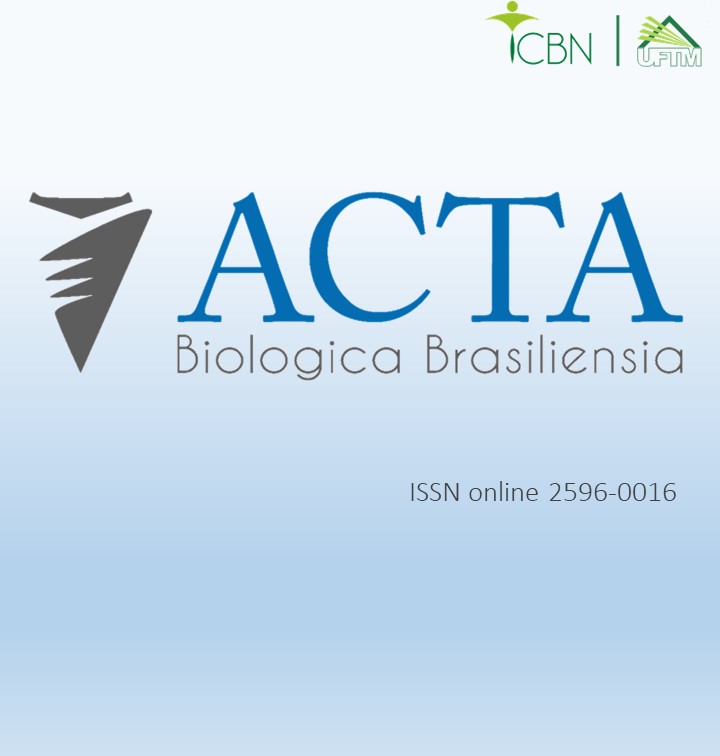COMPOSTOS BIOATIVOS COM POTENCIAL ANTIOXIDANTE EM FLORES COMESTÍVEIS NO RETARDO DO ENVELHECIMENTO CUTÂNEO
DOI:
https://doi.org/10.18554/acbiobras.v7i1.7587Palavras-chave:
envelhecimento cutâneo, fitoquímicos, flores comestíveisResumo
O uso de flores comestíveis na alimentação remonta a centenas de anos e é uma tradição antiga em várias partes do mundo. No entanto, no Brasil, o consumo de flores não é tão difundido, embora diversas espécies possuam compostos bioativos que desempenham um papel crucial na manutenção da saúde. Como resultado, o mercado de flores comestíveis está ganhando destaque tanto no Brasil quanto globalmente. O objetivo do trabalho foi realizar uma revisão na literatura sobre flores comestíveis que contêm compostos bioativos com potencial antioxidante, os quais desempenham um papel na prevenção e retardo do envelhecimento cutâneo. Foi realizada uma busca por pesquisas científicas em bases de dados eletrônicas, utilizando como eixos temáticos de busca: flores comestíveis, compostos bioativos e envelhecimento cutâneo. Segundo dados obtidos, são relatadas mais de 100 espécies florais identificadas como comestíveis. Dentre os compostos bioativos existentes, dois se mostraram mais significativos nas flores comestíveis: compostos fenólicos e carotenoides. Tanto os compostos fenólicos quanto os carotenoides, são considerados importantes antioxidantes naturais, e quando ingeridos, contribuem agindo diretamente nas células, de forma a neutralizar grande parte dos radicais livres, minimizando sua ação nociva, e até mesmo interrompendo a cadeia de propagação das reações oxidativas no organismo e, consequentemente, auxiliando na prevenção do envelhecimento precoce e doenças degenerativas.
Referências
Koike ACR. Compostos bioativos em flores comestíveis processadas por radiação. Tese (Doutorado em Ciências), Universidade de São Paulo, São Paulo, SP, 2015. Disponível em https://www.teses.usp.br/teses/disponiveis/85/85131/tde-17082015-102839/publico/AmandaCristinaRamosKoike.pdf.
Odorizzi CMC, Silva Júnior AAS, Lemos MP. Flores comestíveis: revisão sobre os aspectos nutracêuticos e o uso na alimentação e na gastronomia. Nutrição Brasil. 2014; 13(3): 184-189.
Jacob Filho W. Fatores determinantes do envelhecimento saudável. Boletim do Instituto de Saúde. 2009; (47): 27-32. file:///C:/Users/usuario/Downloads/33817-Texto%20do%20artigo-1602-32827-10-20200728.pdf.
Pizzani L, Silva RC, Bello SF, Hayashi MCPI. A arte da pesquisa bibliográfica na busca do conhecimento. Revista Digital de Biblioteconomia e Ciência da Informação. 2012; 10(1): 53-66. https://periodicos.sbu.unicamp.br/ojs/index.php/rdbci/article/view/1896/pdf_28.
Rop O, Mlcek J, Jurikova T, Neugebauerova J, Vabkova J. Edible flowers – a new promising source of mineral elements in human nutrition. Molecules. 2012; 17(6): 6672-6683. https://www.ncbi.nlm.nih.gov/pmc/articles/PMC6268292/.
Borella J, Martinazzo EG, Aumonde TZ, Amarante L, Moraes DM, Villela FA. Respostas na germinação e no crescimento inicial de rabanete sob ação de extrato aquoso de Piper mikanianum (Kunth) Steudel. Acta Botanica Brasilica. 2012; 26(2): 415-420.
https://www.scielo.br/j/abb/a/RLkVb6MVKRY3dmPYW6jzRZv/?format=pdf&lang=pt
Fernandes L, Casal S, Pereira JA, Saraiva JA, Ramalhosa E. Uma perspectiva nutricional sobre flores comestíveis. Acta Portuguesa de Nutrição. 2016; (6): 32-37. https://actaportuguesadenutricao.pt/wp-content/uploads/2017/01/n6a06.pdf.
Angelo PM, Jorge N. Compostos fenólicos em alimentos – uma breve revisão. Revista do Instituto Adolfo Lutz. 2007; 66(1): 01-09. https://periodicos.saude.sp.gov.br/RIAL/article/view/32841/31672.
Soares SE. Ácidos fenólicos como antioxidantes. Revista de Nutrição. 2002; 15(1): 71-81. https://www.scielo.br/j/rn/a/mZxTyVMspZY9WJgC7SSFnbh/?format=pdf&lang=pt.
Fonseca KZ, Prazeres AGM, Lima CLB, Santos IP, Pamponet JSS. Perguntas mais frequentes sobre flavonoides. Universidade Federal do Recôncavo da Bahia, UFRB, 2016.
Mesquita SS, Teixeira CMLL, Servulo EFC. Carotenoides: propriedades, aplicações e mercado. Revista Virtual de Química. 2017; 9(2). https://rvq-sub.sbq.org.br/index.php/rvq/article/view/1761.
Volp ACP, Renhe IRT, Stringueta PC. Carotenoides: pigmentos naturais como compostos bioativos. Revista Brasileira de Nutrição Clínica. 2011; 26(4): 291-298. http://www.braspen.com.br/home/wp-content/uploads/2016/12/10-Caroten%C3%B3ides-Pigmentos-Naturais-como-Compostos-Bioativos.pdf.
Franzen FL, Richards NSPS, Oliveira MSR, Backes FAAL, Menegaes JF, Zago AP. Caracterização e qualidade nutricional de pétalas de flores ornamentais. Acta Iguazu. 2016; 5(3): 58-70. https://e-revista.unioeste.br/index.php/actaiguazu/article/view/15834.
Fernandes L, Saraiva JÁ, Pereira JA, Casal S, Ramalhosa E. Do jardim à mesa. Voz do Campo. 2015; (181): 08-09. file:///C:/Users/usuario/Downloads/Do_jardim_a_mesa.pdf.
Santos IC, Reis SN, Faccion CE, Carvalho LM. Flores comestíveis: o que é preciso saber. Circular Técnica. 2019; (305): 01-12. https://livrariaepamig.com.br/wp-content/uploads/2023/02/CT-305.pdf.
Kishimoto S, Maoka T, Nakayama M, Ohmlya A. Carotenoid composition in petals of chrysanthemumm (Dendranthema grandiflorum (Ramat.) Kitamura). Phytochemistry. 2004; 65(20). https://pubmed.ncbi.nlm.nih.gov/15474564/.
Fu M, He Z, Zhao Y, Yang J, Mao L. Antioxidant properties and involved compounds of daylily flowers in relation to maturity. Food Chemistry. 2009; 114(4): 1192-1197. https://www.sciencedirect.com/science/article/abs/pii/S0308814608012934.
Lin L, Harnly JM. Identification of the phenolic componentes of Chrysanthemum flower (Chrysanthemum morifolium Ramat). Food Chemistry. 2009; 114(4): 319-326. https://www.sciencedirect.com/science/article/abs/pii/S0308814609011431.
Gonçalves J, Silva GCO, Carlos LA. Compostos bioativos em flores comestíveis. Perspectivas Online: Biológicas & Saúde. 2019; 9(29): 11-20. https://ojs3.perspectivasonline.com.br/biologicas_e_saude/article/view/1719/1377.
Ikram EHK, Eng KH, Jalil AMM, Ismail A, Idris S, Azlan A, Nazri HSM, Diton NAM, Mokhtar RAM. Antioxidant capacity and total phenolic contente of Malaysian underutilized fruits. Journal of Food Composition and Analysis. 2009; 22(5): 388-393. https://www.sciencedirect.com/science/article/abs/pii/S0889157509000933.
Franzen FL. Capacidade antioxidante e antimicrobiana in vitro de extratos de flores comestíveis obtidos pelo método convencional e ultrassom. Dissertação (Mestrado em Ciência e Tecnologia de Alimentos), Universidade Federal de Santa Maria, Santa Maria, RS, 2017. Disponível em https://repositorio.ufsm.br/handle/1/14102.
Carnauba RA. Ação dos compostos bioativos dos alimentos no envelhecimento e longevidade. Revista Brasileira de Nutrição Funcional. 2019; 45(80): 08-13.






